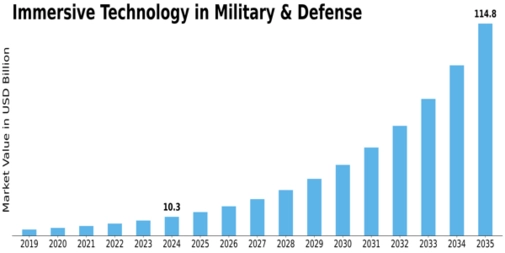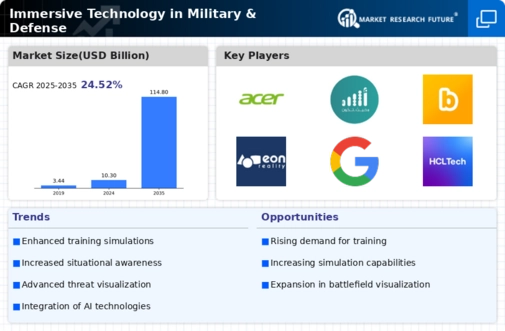Hardware
Head-Mounted Display (HMD)
Gesture Tracking Devices (GTD)
Projectors & Display Walls (PDW)
Software/Platform
Services
Professional
Managed
Mixed Reality (MR)
Virtual Reality (VR)
Augmented Reality (AR)
360 Film
Training & Learning
Emergency Services
Product Development
Sales & Marketing
Immersive Technology in Military & Defense by ComponentHardware
Head-Mounted Display (HMD)
Gesture Tracking Devices (GTD)
Projectors & Display Walls (PDW)
Software/Platform
Services
Professional
Managed
Immersive Technology in Military & Defense by TechnologyMixed Reality (MR)
Virtual Reality (VR)
Augmented Reality (AR)
360 Film
Immersive Technology in Military & Defense by ApplicationTraining & Learning
Emergency Services
Product Development
Sales & Marketing
Immersive Technology in Military & Defense by ComponentHardware
Head-Mounted Display (HMD)
Gesture Tracking Devices (GTD)
Projectors & Display Walls (PDW)
Software/Platform
Services
Professional
Managed
Immersive Technology in Military & Defense by TechnologyMixed Reality (MR)
Virtual Reality (VR)
Augmented Reality (AR)
360 Film
Immersive Technology in Military & Defense by ApplicationTraining & Learning
Emergency Services
Product Development
Sales & Marketing
Immersive Technology in Military & Defense by ComponentHardware
Head-Mounted Display (HMD)
Gesture Tracking Devices (GTD)
Projectors & Display Walls (PDW)
Software/Platform
Services
Professional
Managed
Immersive Technology in Military & Defense by TechnologyMixed Reality (MR)
Virtual Reality (VR)
Augmented Reality (AR)
360 Film
Immersive Technology in Military & Defense by ApplicationTraining & Learning
Emergency Services
Product Development
Sales & Marketing
Immersive Technology in Military & Defense by ComponentHardware
Head-Mounted Display (HMD)
Gesture Tracking Devices (GTD)
Projectors & Display Walls (PDW)
Software/Platform
Services
Professional
Managed
Immersive Technology in Military & Defense by TechnologyMixed Reality (MR)
Virtual Reality (VR)
Augmented Reality (AR)
360 Film
Immersive Technology in Military & Defense by ApplicationTraining & Learning
Emergency Services
Product Development
Sales & Marketing
Germany Outlook (USD Billion, 2018-2032)
Immersive Technology in Military & Defense by ComponentHardware
Head-Mounted Display (HMD)
Gesture Tracking Devices (GTD)
Projectors & Display Walls (PDW)
Software/Platform
Services
Professional
Managed
Immersive Technology in Military & Defense by TechnologyMixed Reality (MR)
Virtual Reality (VR)
Augmented Reality (AR)
360 Film
Immersive Technology in Military & Defense by ApplicationTraining & Learning
Emergency Services
Product Development
Sales & Marketing
Immersive Technology in Military & Defense by ComponentHardware
Head-Mounted Display (HMD)
Gesture Tracking Devices (GTD)
Projectors & Display Walls (PDW)
Software/Platform
Services
Professional
Managed
Immersive Technology in Military & Defense by TechnologyMixed Reality (MR)
Virtual Reality (VR)
Augmented Reality (AR)
360 Film
Immersive Technology in Military & Defense by ApplicationTraining & Learning
Emergency Services
Product Development
Sales & Marketing
Immersive Technology in Military & Defense by ComponentHardware
Head-Mounted Display (HMD)
Gesture Tracking Devices (GTD)
Projectors & Display Walls (PDW)
Software/Platform
Services
Professional
Managed
Immersive Technology in Military & Defense by TechnologyMixed Reality (MR)
Virtual Reality (VR)
Augmented Reality (AR)
360 Film
Immersive Technology in Military & Defense by ApplicationTraining & Learning
Emergency Services
Product Development
Sales & Marketing
Immersive Technology in Military & Defense by ComponentHardware
Head-Mounted Display (HMD)
Gesture Tracking Devices (GTD)
Projectors & Display Walls (PDW)
Software/Platform
Services
Professional
Managed
Immersive Technology in Military & Defense by TechnologyMixed Reality (MR)
Virtual Reality (VR)
Augmented Reality (AR)
360 Film
Immersive Technology in Military & Defense by ApplicationTraining & Learning
Emergency Services
Product Development
Sales & Marketing
Immersive Technology in Military & Defense by ComponentHardware
Head-Mounted Display (HMD)
Gesture Tracking Devices (GTD)
Projectors & Display Walls (PDW)
Software/Platform
Services
Professional
Managed
Immersive Technology in Military & Defense by TechnologyMixed Reality (MR)
Virtual Reality (VR)
Augmented Reality (AR)
360 Film
Immersive Technology in Military & Defense by ApplicationTraining & Learning
Emergency Services
Product Development
Sales & Marketing
Immersive Technology in Military & Defense by ComponentHardware
Head-Mounted Display (HMD)
Gesture Tracking Devices (GTD)
Projectors & Display Walls (PDW)
Software/Platform
Services
Professional
Managed
Immersive Technology in Military & Defense by TechnologyMixed Reality (MR)
Virtual Reality (VR)
Augmented Reality (AR)
360 Film
Immersive Technology in Military & Defense by ApplicationTraining & Learning
Emergency Services
Product Development
Sales & Marketing
Immersive Technology in Military & Defense by ComponentHardware
Head-Mounted Display (HMD)
Gesture Tracking Devices (GTD)
Projectors & Display Walls (PDW)
Software/Platform
Services
Professional
Managed
Immersive Technology in Military & Defense by TechnologyMixed Reality (MR)
Virtual Reality (VR)
Augmented Reality (AR)
360 Film
Immersive Technology in Military & Defense by ApplicationTraining & Learning
Emergency Services
Product Development
Sales & Marketing
Immersive Technology in Military & Defense by ComponentHardware
Head-Mounted Display (HMD)
Gesture Tracking Devices (GTD)
Projectors & Display Walls (PDW)
Software/Platform
Services
Professional
Managed
Immersive Technology in Military & Defense by TechnologyMixed Reality (MR)
Virtual Reality (VR)
Augmented Reality (AR)
360 Film
Immersive Technology in Military & Defense by ApplicationTraining & Learning
Emergency Services
Product Development
Sales & Marketing
Immersive Technology in Military & Defense by ComponentHardware
Head-Mounted Display (HMD)
Gesture Tracking Devices (GTD)
Projectors & Display Walls (PDW)
Software/Platform
Services
Professional
Managed
Immersive Technology in Military & Defense by TechnologyMixed Reality (MR)
Virtual Reality (VR)
Augmented Reality (AR)
360 Film
Immersive Technology in Military & Defense by ApplicationTraining & Learning
Emergency Services
Product Development
Sales & Marketing
Immersive Technology in Military & Defense by ComponentHardware
Head-Mounted Display (HMD)
Gesture Tracking Devices (GTD)
Projectors & Display Walls (PDW)
Software/Platform
Services
Professional
Managed
Immersive Technology in Military & Defense by TechnologyMixed Reality (MR)
Virtual Reality (VR)
Augmented Reality (AR)
360 Film
Immersive Technology in Military & Defense by ApplicationTraining & Learning
Emergency Services
Product Development
Sales & Marketing
Immersive Technology in Military & Defense by ComponentHardware
Head-Mounted Display (HMD)
Gesture Tracking Devices (GTD)
Projectors & Display Walls (PDW)
Software/Platform
Services
Professional
Managed
Immersive Technology in Military & Defense by TechnologyMixed Reality (MR)
Virtual Reality (VR)
Augmented Reality (AR)
360 Film
Immersive Technology in Military & Defense by ApplicationTraining & Learning
Emergency Services
Product Development
Sales & Marketing
Immersive Technology in Military & Defense by ComponentHardware
Head-Mounted Display (HMD)
Gesture Tracking Devices (GTD)
Projectors & Display Walls (PDW)
Software/Platform
Services
Professional
Managed
Immersive Technology in Military & Defense by TechnologyMixed Reality (MR)
Virtual Reality (VR)
Augmented Reality (AR)
360 Film
Immersive Technology in Military & Defense by ApplicationTraining & Learning
Emergency Services
Product Development
Sales & Marketing
Immersive Technology in Military & Defense by ComponentHardware
Head-Mounted Display (HMD)
Gesture Tracking Devices (GTD)
Projectors & Display Walls (PDW)
Software/Platform
Services
Professional
Managed
Immersive Technology in Military & Defense by TechnologyMixed Reality (MR)
Virtual Reality (VR)
Augmented Reality (AR)
360 Film
Immersive Technology in Military & Defense by ApplicationTraining & Learning
Emergency Services
Product Development
Sales & Marketing
Immersive Technology in Military & Defense by ComponentHardware
Head-Mounted Display (HMD)
Gesture Tracking Devices (GTD)
Projectors & Display Walls (PDW)
Software/Platform
Services
Professional
Managed
Immersive Technology in Military & Defense by TechnologyMixed Reality (MR)
Virtual Reality (VR)
Augmented Reality (AR)
360 Film
Immersive Technology in Military & Defense by ApplicationTraining & Learning
Emergency Services
Product Development
Sales & Marketing
Immersive Technology in Military & Defense by ComponentHardware
Head-Mounted Display (HMD)
Gesture Tracking Devices (GTD)
Projectors & Display Walls (PDW)
Software/Platform
Services
Professional
Managed
Immersive Technology in Military & Defense by TechnologyMixed Reality (MR)
Virtual Reality (VR)
Augmented Reality (AR)
360 Film
Immersive Technology in Military & Defense by ApplicationTraining & Learning
Emergency Services
Product Development
Sales & Marketing
Immersive Technology in Military & Defense by ComponentHardware
Head-Mounted Display (HMD)
Gesture Tracking Devices (GTD)
Projectors & Display Walls (PDW)
Software/Platform
Services
Professional
Managed
Immersive Technology in Military & Defense by TechnologyMixed Reality (MR)
Virtual Reality (VR)
Augmented Reality (AR)
360 Film
Immersive Technology in Military & Defense by ApplicationTraining & Learning
Emergency Services
Product Development
Sales & Marketing














Leave a Comment